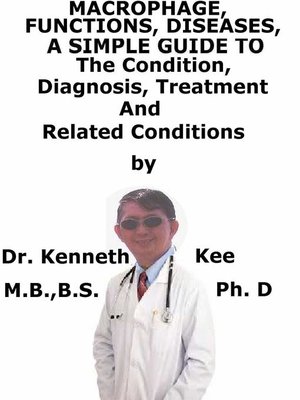Macrophage, Functions, Diseases, a Simple Guide to the Condition, Diagnosis, Treatment and Related Conditions
ebook
By Kenneth Kee

Sign up to save your library
With an OverDrive account, you can save your favorite libraries for at-a-glance information about availability. Find out more about OverDrive accounts.
Find this title in Libby, the library reading app by OverDrive.



Search for a digital library with this title
Title found at these libraries:
| Library Name | Distance |
|---|---|
| Loading... |
This book describes Macrophage, Functions, Diseases, Diagnosis and Treatment and Related Diseases
Macrophages (big eater) are cells formed by the transformations of monocytes in tissues.
The macrophages in humans are about 21 micrometers (0.00083in) in diameter.
Parts of a Macrophage:
1.Pathogens – engulfed germs
2.Phagosome – ingested pathogen in macrophage
3.Lysosomes - enzyme to digest pathogens
4.Waste material
5.Cytoplasm
6.Cell membrane
Macrophages are fighter cells specialized in the detection, phagocytosis and destruction of bacteria and other harmful organisms.
Also, they can also exhibit antigens to T cells and start inflammation by releasing cytokines that trigger other cells.
Macrophages begin from blood monocytes that depart from the circulation to differentiate in different tissues.
This heterogeneity is indicated in their appearance, the type of pathogens they can identify, and the levels of inflammatory cytokines they form (i.e. IL-1, IL-6, tumor necrosis factor alpha).
Also, macrophages form reactive oxygen species, such as nitric oxide, that can destroy phagocytes and bacteria.
Macrophages travel to and circulate within almost every tissue, searching for pathogens or removing dead cells.
Type of macrophage
1.Alveolar macrophage
Location - Lung alveoli
Function - Phagocytosis of small particle, dead cell or bacteria.
They also start and control immunity to respiratory pathogen
2.Kupffer cells
Location - Liver
Function - Start immune responsesand hepatic tissue remodeling
3. Microglia
Location - Central nervous system
Function - Removal of old or dead neuron and control of immunity in the brain
4. Splenic macrophages (marginal zone, metallophilic and red pulp macrophage)
Location - Spleen marginal zone, red and white pulp
Function - Removal of old red blood cell
Macrophages are able to identify bacteria and other microorganisms using a system of identification receptors such as Toll-like receptors (TLRs).
Life and Death of Macrophage:
My name is Macrophage the macrophage.
I was named Macrophage by my friends who feel there is no other name for me.
Some of them even wanted to call me Super Phage or Big Eater.
We are white blood cells within tissues produced by the division of monocytes.
Our cells are large about 21 micrometers in diameter.
We often have an elongated irregular shape that reflects our amoeboid wandering nature.
There may be many of us in one region but we are not contiguous.
We display our inclusions only as a result of substantial phagocytic activity.
The Monocytes and we are phagocytes acting in both:
1. Non-specific defenses (innate immunity)
2. Specific defense mechanisms (adaptive immunity) of humans.
Our role is to:
1. Phagocytose (engulf and then digest) cellular debris and pathogens either as stationary or as mobile cells
2. Stimulate lymphocytes and other immune cells to respond to the pathogen.
We move by action of amoeboid movement.
When a white blood cell enters the damaged tissue through the endothelium of a blood vessel, it goes through a series of changes to become one of us macrophages
Unlike short-lived neutrophils that survive only a few days, we survive longer in the body up to a maximum of several months.
An important role of us macrophages is the removal of necrotic cellular debris by our fixed macrophage cells in the lungs, liver, spleen, bone
When I ingest a pathogen, the pathogen becomes trapped in a phagosome which then fuses with a lysosome.
Within the...







